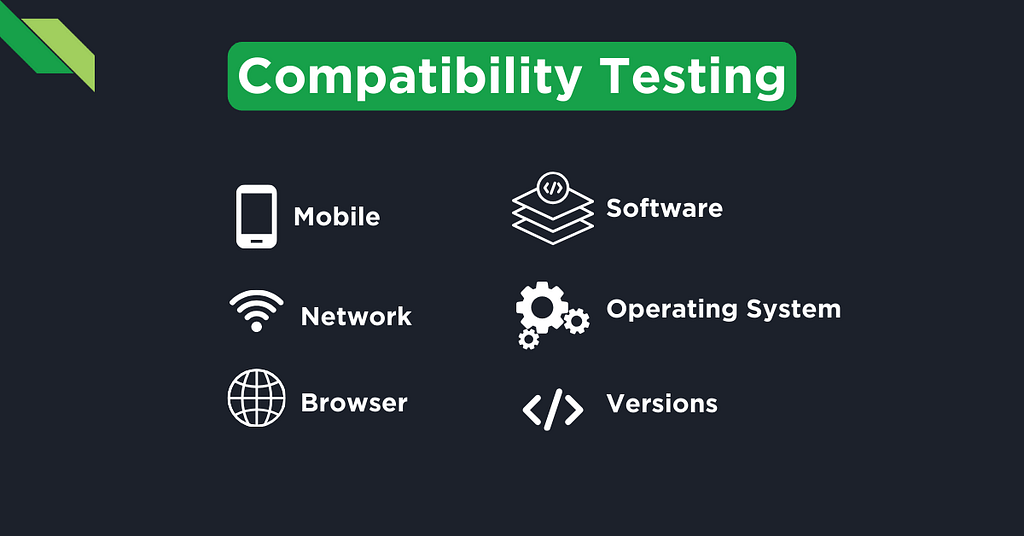Last Updated on 2025-01-06
Software compatibility issues cause 32% of application failures in enterprise systems, according to IBM’s 2024 Software Quality Report. Compatibility testing identifies these issues before deployment. Modern software must work across multiple platforms, browsers, and devices.
A successful compatibility test ensures your application runs smoothly across different environments.
According to Gartner’s 2024 Digital Experience Survey, organizations lose an average of $47,000 per hour during system outages. Software compatibility testing reduces these costly disruptions.
The growing diversity of devices and platforms makes this testing crucial. According to Statista’s latest report, mobile devices will account for 58.5% of global web traffic in 2024. Testing across different platforms safeguards user experience and prevents revenue loss.
Let’s explore what compatibility testing entails and its various types. Understanding these fundamentals helps build effective testing strategies. Your software’s success depends on comprehensive testing coverage.
What is Compatibility Testing?

Compatibility testing verifies software functionality across different environments and configurations. This testing process examines how applications perform on various operating systems. Your software needs validation across browsers, devices, and network configurations.
Hardware Compatibility Testing
Software applications must function correctly with different hardware components. Hardware compatibility testing checks system performance with various processors and memory configurations. Different screen resolutions and graphics cards require thorough testing.
Operating System Compatibility
Modern applications must work seamlessly across Windows, macOS, Linux, and mobile operating systems. Each OS version presents unique challenges for software functionality. Testing validates application behavior across multiple OS environments.
Browser Compatibility Testing
Web applications require testing across Chrome, Firefox, Safari, and other popular browsers. Browser compatibility testing ensures a consistent user experience across different versions. According to W3Counter’s 2024 report, Chrome dominates with a 64% market share, followed by Safari with a 19% share.
Network Compatibility
Applications must perform well under various network conditions and bandwidth limitations. Network compatibility testing validates software behavior across different connection speeds. Testing includes verification of data synchronization and offline functionality.
Beyond these basic categories, compatibility testing is split into two fundamental types. Understanding these types helps create comprehensive testing strategies. Let’s examine how backward and forward compatibility shape testing approaches.
Types of Compatibility Testing: Backward and Forward
Compatibility testing is divided into two critical categories. Each type addresses different aspects of software evolution, and testing teams must consider both directions of compatibility.
Backwards Compatibility Testing
Backwards compatibility ensures new software works with older versions. Users must access their existing data in newer versions. Legacy system integration requires thorough backwards testing.
Systems often store years of valuable user data. Backwards compatibility preserves access to historical information. According to Microsoft’s 2024 Enterprise Survey, 67% of businesses require 5+ years of backwards compatibility.
Forward Compatibility Testing
Forward compatibility prepares software for future system updates. Testing validates software behavior with upcoming platform changes. Early testing prevents future compatibility issues.
Development teams anticipate upcoming technology changes. Forward compatibility reduces future maintenance costs. Testing includes verification with beta versions of platforms.
Understanding these types leads us to explore their benefits. Effective compatibility testing services deliver value across multiple dimensions. Let’s examine how these testing approaches benefit your software development.
4 Benefits of Compatibility Testing Services
Compatibility testing reduces development costs and improves user satisfaction rates. According to Forrester’s 2024 Software Quality Report, early compatibility testing saves companies 3-5x in bug-fixing costs. Professional testing services ensure comprehensive environment coverage.
1. Cost Reduction Through Early Detection
Early compatibility testing identifies issues before they reach production environments. Testing services help catch compatibility problems during the development phases. Quick issue detection reduces the cost of fixes and updates.
2. Enhanced User Experience
Cross-platform compatibility ensures consistent performance for all users. A compatibility test validates software behavior across different user environments. Compatible software leads to higher user retention and satisfaction.
3. Market Reach Expansion
Software that works across multiple platforms reaches more potential users. Compatibility testing services verify functionality for different market segments. Testing enables confident expansion into new device markets.
4. Security and Performance Benefits
Thorough compatibility testing reveals security vulnerabilities across platforms. Performance bottlenecks become visible through systematic testing approaches. According to CyberSecurity Ventures, compatible software reduces security incidents by 47%.
These benefits materialize through systematic testing methods. Let’s explore the practical approaches to compatibility testing. Understanding these methods helps implement effective testing strategies.
Compatibility Testing Methods for Software Success
Systematic testing methods ensure thorough coverage across different environments. Test environments must accurately mirror real-world user conditions. Professional testers follow established compatibility testing protocols.
Manual Testing Approaches
Testers perform hands-on verification of software functionality across platforms. Manual testing catches user interface inconsistencies and behavior issues. Human testers validate the actual user experience across environments.
Automated Testing Tools
Modern compatibility testing tools automate repetitive verification tasks. Compatibility testing tools like BrowserStack and Selenium lead the market. Automated tools test hundreds of environment combinations efficiently.
Testing Environment Setup
Virtual machines simulate different operating systems and configurations. Cloud-based testing platforms provide access to multiple testing environments. Docker containers enable consistent testing environments across teams.
These methods form the foundation of implementation strategies. Let’s examine how to implement these practices. Proper implementation ensures testing effectiveness.
Implementing Your Compatibility Testing Strategy
Start with defining essential platforms and configurations for testing. Create a priority list based on your target user demographics. According to IDC’s 2024 Device Usage Report, testing should cover 95% of user environments.
Essential Testing Steps
Document baseline requirements for each supported platform. A compatibility test report guides development priorities effectively. Test critical functionality across primary operating systems first.
Risk-Based Testing Approach
Focus initial testing on high-risk platform combinations. Identify critical user paths requiring compatibility verification. Compatibility testing in software testing requires strategic resource allocation.
Continuous Testing Integration
Incorporate compatibility tests into your development pipeline. Automated compatibility checks run with each software update. Regular testing prevents compatibility issues from accumulating.
While implementation sets the foundation, challenges often arise. Understanding common issues helps teams prepare better solutions. Let’s explore these challenges and their solutions.
5 Common Compatibility Testing Challenges
Software teams face evolving compatibility challenges across platforms. Browser updates create new testing requirements every 6-8 weeks. Network diversity complicates testing scenarios significantly.
1. Version Control Issues
Different software versions create complex testing matrices. Version compatibility requires testing across multiple update combinations. Testing services track version dependencies systematically.
2. Hardware Configuration Challenges
Device fragmentation increases testing complexity exponentially. Mobile devices introduce unique hardware compatibility requirements. Testing must cover various screen sizes and processing capabilities.
3. Network Variability
Applications behave differently under various network conditions. Mobile networks present unique compatibility challenges. Cloud applications require testing across different connection speeds.
4. Browser Engine Differences
Rendering engines process web content differently. JavaScript implementations vary across browser versions. According to ChromeStatus 2024, browser features change monthly.
5. Security Protocol Variations
Security requirements differ across platforms and regions. Encryption standards evolve with new security threats. Testing must verify security protocol compatibility.
Addressing these challenges requires proper tools and services. Let’s explore how to select the right testing solutions. Proper tool selection enhances testing effectiveness.
Choosing Compatibility Testing Tools and Services
Top compatibility testing tools offer specialized features for different needs. Leading testing platforms provide coverage for over 2,500 device combinations. Full Scale’s testing services ensure comprehensive platform coverage.
Essential Testing Tools
BrowserStack validates web applications across browser configurations. Selenium automates cross-browser compatibility testing effectively. LambdaTest provides real-device testing capabilities.
Cloud Testing Platforms
Cloud platforms offer scalable testing environments on demand. Virtual machines enable quick environment configuration changes. Docker containers standardize testing environments efficiently.
Mobile Testing Solutions
Emulators test mobile applications across different devices. Real device testing validates actual user experiences. Cross-platform frameworks require specialized testing approaches.
Service Provider Selection
Professional testing services offer expertise and established processes. Full Scale provides dedicated testing teams for complex projects. Testing partnerships reduce internal resource requirements.
Measuring success helps validate your testing approach. Let’s examine key metrics for testing effectiveness. Data-driven insights improve testing outcomes.
Measuring Compatibility Testing Success
Clear metrics help track compatibility testing effectiveness. Test coverage metrics indicate testing completeness across platforms. According to DevOps Research 2024, successful teams achieve 80% platform coverage.
Key Performance Indicators
Track issue detection rates across different environments. Measure time spent resolving compatibility problems. Monitor user-reported compatibility issues after release.
Coverage Analysis
Document tested platform and browser combinations. Track testing progress against planned coverage targets. Identify gaps in compatibility testing coverage.
Quality Metrics
Record defect detection rates during compatibility testing. Track compatibility issues in production environments. Measure user satisfaction across different platforms.
Return on Investment
Calculate cost savings from early issue detection. Compare testing costs against prevented production issues. Document the business impact of compatibility testing.
These measurements demonstrate the value of professional testing services. Let’s explore how Full Scale delivers comprehensive testing solutions. Our expertise ensures testing success.
Full Scale Compatibility Testing Services
Full Scale delivers comprehensive compatibility testing solutions. Our testing teams work across all major platforms and environments. Quality assurance experts ensure thorough compatibility verification.
Expert Testing Teams
Dedicated QA professionals handle complex testing requirements. Testing teams use industry-leading tools and methodologies. Our experts maintain current platform knowledge.
Flexible Service Models
Choose service levels that match your testing needs. Scale testing resources based on project requirements. Teams adapt to your development schedule efficiently.
Process Integration
Testing services integrate with your development workflow. Regular communication ensures alignment with project goals. Detailed reporting provides clear issue documentation.
Compatibility testing ensures software quality across diverse environments. Professional testing services effectively reduce compatibility risks. Full Scale helps deliver reliable software for all users.
Contact Full Scale today to discuss your compatibility testing needs. Our teams ensure your software works flawlessly across platforms.
Schedule Your Free Discovery Call Today
FAQ: Compatibility Testing
What aspects do a compatibility test check-in software applications?
A compatibility test examines software performance across operating systems, browsers, and hardware configurations. It checks functionality, user interface consistency, and data handling. Testing verifies seamless operation in all supported environments.
How do compatibility testing services implement testing methods?
Professional compatibility testing services use manual and automated approaches. Testing teams create comprehensive test matrices for platform combinations. Quality assurance experts manage environment simulation and real device testing.
What are the key phases of software compatibility testing?
The software compatibility testing involves requirement analysis, test execution, and results validation. Each phase requires specific compatibility testing tools. Testing services help streamline these phases effectively.
When should companies engage in compatibility testing services?
Companies should begin compatibility testing early in development cycles. A compatibility tester can identify issues before they become costly. Regular testing continues throughout development.
How does backwards compatibility testing impact software updates?
Backwards compatibility testing ensures new versions work with legacy systems. It validates data migration and feature accessibility. Testing prevents disruption during system upgrades.
What compatibility testing tools do professional services use?
Essential compatibility testing tools include virtual machines and automated frameworks. Testing services provide access to specialized testing environments. Full Scale offers comprehensive testing platforms.
How long does professional compatibility testing take?
Test cycles vary based on application complexity and platform requirements. Compatibility test reports typically require 2-4 weeks to complete. Maintenance testing continues between major releases.
What skills should a compatibility tester possess?
Testers need experience with multiple operating systems and testing frameworks. They should understand compatibility testing in software testing methodologies. Professional certification demonstrates expertise.
Which platforms need priority in compatibility testing services?
Prioritize based on user demographics and market requirements. Test common operating systems and browser combinations first. Mobile compatibility testing grows increasingly crucial.
How does Full Scale enhance software compatibility testing?
Full Scale provides expert compatibility testing services and comprehensive solutions. Our services cover all aspects of testing requirements. Contact us to develop your testing strategy.

Matt Watson is a serial tech entrepreneur who has started four companies and had a nine-figure exit. He was the founder and CTO of VinSolutions, the #1 CRM software used in today’s automotive industry. He has over twenty years of experience working as a tech CTO and building cutting-edge SaaS solutions.
As the CEO of Full Scale, he has helped over 100 tech companies build their software services and development teams. Full Scale specializes in helping tech companies grow by augmenting their in-house teams with software development talent from the Philippines.
Matt hosts Startup Hustle, a top podcast about entrepreneurship with over 6 million downloads. He has a wealth of knowledge about startups and business from his personal experience and from interviewing hundreds of other entrepreneurs.





